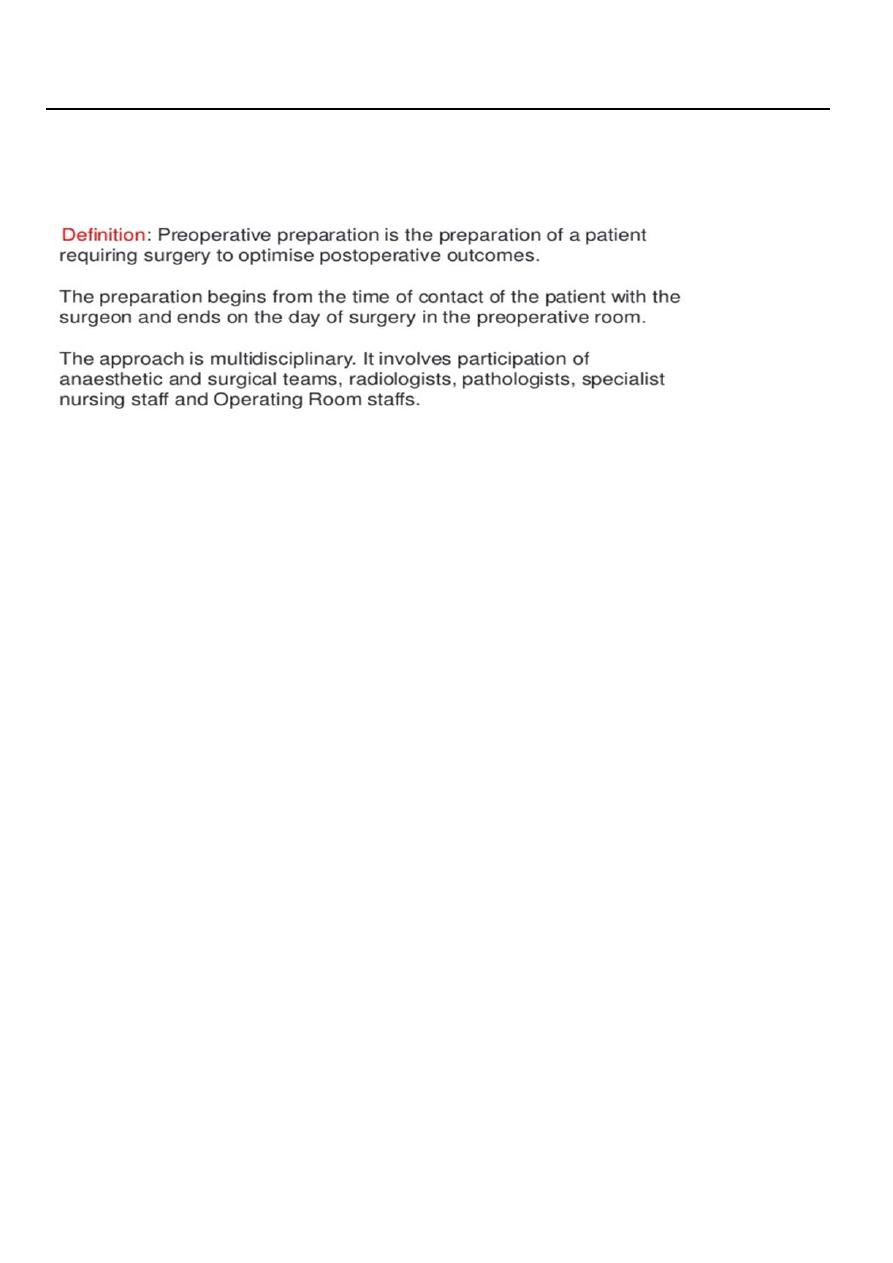
1
Third stage
Surgery
Lec-1
.د
محمد صالح
1/1/2016
Preoperative preparation
History
Principles of history-taking
■ Listen: what does the patient see as the problem? (Open questions)
■ Clarify: what does the patient expect? (Closed questions)
■ Narrow the differential diagnosis. (Focused questions)
■ Fitness: what other comorbidities exist? (Fixed questions)
History of the presenting complaint
Past medical history
Drug history
Social history
Cardiovascular
■ Ischemic heart disease – angina, myocardial infarction
■ Hypertension
■ Heart failure
■ Dysrhythmias
■ Peripheral vascular disease
■ Deep vein thrombosis and pulmonary embolism
■ Anemia

2
Respiratory
■ Chronic obstructive pulmonary disease
■ Asthma
■ Fibrotic lung conditions
■ Respiratory infections
■ Malignancy
Gastrointestinal
■ Peptic ulcer disease and gastro-esophageal reflux
■ Bowel habit – bleeding per rectum, obstruction
■ Malignancy
■ Liver disease – jaundice, alcohol, coagulopathy
Genitourinary tract
■ Urinary tract infection
■ Prostatism
■ Renal dysfunction
Neurological
■ Epilepsy
■ Cerebrovascular accidents and transient ischemic attacks
■ Psychiatric disorder
Endocrine/metabolic
■ Diabetes
■ Thyroid dysfunction
■ Phaeochromocytoma
■ Porphyria

3
Locomotor system
■ Osteoarthritis
■ Inflammatory arthropathy such as rheumatoid arthritis, including neck instability
Infectious diseases
■ Human immunodeficiency virus
■ Hepatitis
■ Tuberculosis
Previous surgery
■ Types of anesthetic and any problems encountered
■ Have any members of the patient’s family had particular problems with anesthesia?
Examination
General
■ Anemia, jaundice, cyanosis, nutritional status, teeth, feet, leg ulcers (sources of infection)
Cardiovascular
■ Pulse, blood pressure, heart sounds, bruits, peripheral pulses, peripheral oedema
Respiratory
■ Respiratory rate and effort, chest expansion and percussion note, breath sounds, oxygen
saturation
Gastrointestinal
■ Abdominal masses, ascites, bowel sounds, bruits, herniae, genitalia
Neurological
■ Conscious level, any pre-existing cognitive impairment or confusion, deafness,
neurological status of limbs
Investigations
1- Full blood count young woman with menorrhagia and older patient
2- Urea and electrolytes
- Over the age of 65

4
- lose a significant amount of blood in theatre
- History of cardiovascular, pulmonary or renal problems.
- Diuretic taking patients
3- Liver function tests
these are indicated in patients with jaundice
hepatitis, cirrhosis, malignancy, portal hypertension, poor nutritional reserves or clotting
problems
4-Clotting screen
Or any patient on anticoagulants, with compromised liver function tests or evidence of a
bleeding diathesis.
5-Arterial blood gases
Assessment of some respiratory conditions,
6-Electrocardiography
-anyone over the age of 65???, 40year?
- In all patients in whom significant blood loss is possible
- All patent with a history of cardiovascular, pulmonary or anesthetic problems.
7-Chest radiography
This is not usually required unless the patient has a significant
cardiac history (including hypertension) or respiratory problems.
in IRAQ is different due to TB.
8- Human chorionic gonadotrophin
- in blood or urine and used to confirm pregnancy. It is essential in all female patients of
childbearing age with abdominal pain to exclude an ectopic pregnancy and in any
unconscious female patient of childbearing age.
9-Sickle cell test
Usually the patient with sickle cell disease will know that they have this and inform the
surgical team
10-Hepatitis/human immunodeficiency virus serology
Testing should be undertaken in any patient with a past history of high-risk exposure to
infected body fluids, hepatitis or disorders associated with acquired immunodeficiency
syndrome. .

5
11- Other radiological investigations
Patients with rheumatoid arthritis may have an unstable cervical spine, in which case the
spinal cord can be injured during intubation. radiographs should be obtained preoperatively
to check for instability.
Orthopaedic surgery often requires careful planning on the basis of recent radiographs.
12-Further cardiac evaluation
Previous discussion with the anesthetist and/or a cardiologist is advisable if there are cardiac
problems. A resting ECG does not reliably predict ischemic perioperative events. ECHO, A
ventricular ejection fraction of less than 35%, however, indicates a high risk of cardiac
complications.
13- Further respiratory evaluation
Thoracic surgery usually requires a thorough respiratory work-up preoperatively. Otherwise,
this is only indicated in patients with severe chronic obstructive airways disease [forced
expiratory volume in 1 s (FEV1) of < 40%] or poorly controlled asthma in
which preoperative optimization might be possible.
14-Temperature
Patients with a pyrexia should not be operated on until the cause
has been identified and corrected if possible.
15-Urinalysis
Dipstick testing of urine is usually carried out preoperatively. It can detect urinary infection,
biliuria, glycosuria and inappropriate osmolality. More detailed microscopic or biochemical
analysis is indicated if the patient has a history of urinary tract problems or
Management plan
Key points in the management plan discussion
■ Provide all of the information necessary for the patient to make an informed decision
■ Use language that the patient will understand
■ Discuss the options rather than telling the patient what will be done
■ Give the patient time to think things over
■ Encourage the patient to discuss things with a trusted friend/partner
■ Suggest that the patient write down a list of points that he or she wishes to discuss

6
SPECIFIC PREOPERATIVE PROBLEMS
Cardiovascular disease
Hypertension
- Systolic pressures ≥ 160 mmHg
- Diastolic pressures ≥ 95 mmHg
- Elective surgery deferred until their blood pressure is under control.
- Newly diagnosed hypertension may need further investigation look for an underlying
cause; the medical team may need to be involved.
-For an acute admission requiring urgent surgery the blood pressure may need to be
controlled more rapidly.
- It can be dangerous for a patient’s blood pressure to drop precipitously and this should be
carried out with the assistance of the medical team.
Ischemic heart disease, including recent myocardial infarction
Recent myocardial infarction is a strong contraindication to elective anesthesia. There is a
significant mortality rate from anesthesia within 3 months of infarction and elective
procedures should ideally be delayed until at least 6 months have elapsed.
Significant or worsening angina needs investigation by a cardiologist before elective surgery
If urgent surgery isrequired, aggressive medical therapy is indicated and meticulous
optimisation of oxygenation and fluid balance throughout the
perioperative period must be obtained
Dysrhythmias
Fast atrial fibrillation must be controlled before surgery
Pace maker required preoperatively,in particular second- or third-degree heart block. If a
pacemaker
Most standard pacemakers are stable during anaesthesia but only bipolar diathermy should
be used whenever possible.
Cardiac failure
This needs careful work-up preoperatively and will require specialist medical input.
Oxygenation and fluid balance are of critical importance in these patients and must be
meticulously monitored and documented

7
Anemia and blood transfusion
Preoperative transfusion should be considered if the preoperative hemoglobin concentration
is below 8 g dl–1 or if the patient is symptomatic or actively losing blood
Respiratory disease
Infection
-Significant lower respiratory tract infections should be treated before surgery .
-Patients with bronchiectasis and chronically infected sputum may need appropriate
antibiotics combined with intensive physiotherapy..
Asthma
The patient’s usual inhalers should be continue, may need oral steroid cover. .
Chronic obstructive pulmonary disease
The anaesthetist must be informed if the chronic obstructive pulmonary disease (COPD) is
significant, as regional anaesthetic techniques may need to be considered. Appropriate
postoperative
- intensive therapy unit (ITU) bed.
Pulmonary fibrosis
There is no evidence that any treatment alters the course of disease but inform anaesthetist
If the patient smokes they should be asked to stop at least 4 weeks before the surgery
Gastrointestinal disease
Malnutrition
In the malnourished patient, treatment with nutritional support for a minimum of 2 weeks
before surgery is required to have any impact on subsequent morbidity.
Obesity
Obesity is defined as a BMI of more than 30. These patients are at an increased risk of a
number of postoperative complications.
In some cases it might be better for the patient to delay surgery until they have lost weight.
Problems of surgery in the obese Increased risk of:
■ Difficulty intubating
■ Aspiration

8
■ Myocardial infarction
■ Cerebrovascular accident
■ Deep vein thrombosis and pulmonary embolism
■ Respiratory compromise
■ Poor wound healing/infection
■ Pressure sores
■ Mechanical problems – lifting, transferring, operating table
Regurgitation risk
Pulmonary aspiration can lead to acid pneumonitis, severe bronchospasm,
pneumonia and death.
A frequently used regime is ‘no solids for 6 hours’ and ‘no clear fluids for 4 hours’ before
surgery.
Other management strategies may include the preoperative use of H2-receptor blockade, a
nasogastric tube to empty a significantly distended stomach and specific anesthetic
techniques.
Surgery in the jaundiced patient
Causes of jaundice:
■ Secondary complications of surgery:
■ Clotting disorders need vitamin k
■ Hepatorenal syndrome need hydration
■ Infection need antibiotic
Renal impairment
■ Prerenal:
Dehydration, Poor perfusion
■ Renal:
Acute – volume depletion, platelet function, immunosuppression
Chronic – fluid balance, ?dialysis, ? transplantation

9
■ Postrenal:
Obstruction – calculi, prostate, blocked
Catheter
Urinary tract infection
Metabolic disorders
Diabetes
Surgical risks for the diabetic patient
■ Increased risk of sepsis – local and general
■ Neuropathic complications – pressure care
■ Vascular complications – cardiovascular, cerebrovascular, peripheral
■ Renal complications
■ Fluid and electrolyte disturbances
Adrenocortical suppression
Patients receiving oral adrenocortical steroids regularly (including up to 2 months before
surgery) will have a degree of adrenocortical suppression. They will require extra doses of
steroids around the time of surgery to avoid an Addisonian crisis
Coagulation disorders
Patients taking drugs that interfere with the clotting Cascades
For simple atrial fibrillation, warfarin can usually be stopped 3–4 days before surgery and
then restarted at the normal dosage level on the evening after surgery.
Check that the international normalized ratio (INR) has dropped to 1.5 or lower before
surgery
Deep vein thrombosis ( DVT )
Risk factors for thrombosis
■ Increasing age
■ Significant medical comorbidities (particularly malignancy)
■ Trauma or surgery (especially of the abdomen, pelvis and lower limbs)

11
■ Pregnancy/puerperium
■ Immobility (including a lower limb plaster)
■ Obesity
■ Family/personal history of thrombosis
■ Drugs, e.g. oestrogen, smoking
Risk groups for thrombosis according to surgeryLow risk
■ Minor surgery (less than 30 min), no risk factors, any age
■ Major surgery (more than 30 min), no risk factors, less than age 40
■ Minor trauma or medical illness Moderate risk
■ Major surgery (not orthopaedic or abdominal cancer), age 40+ or other risk factor
■ Major medical illness, trauma or burns
■ Minor surgery, trauma or illness in patient with a family/personal history High risk
■ Major surgery (elective or trauma orthopaedic, cancer) of the pelvis, hip or lower limb
■ Major surgery, trauma or illness in a patient with a family/personal history
■ Lower limb paralysis/amputation
Prophylaxis against thrombosis
Mechanical
■ Early mobilisation
■ Neuraxial anaesthesia
■ Leg compression stockings
■ Calf and foot pumpsPharmacological
■ Heparin and low molecular weight heparin
■ Warfarin
■ Aspirin
Neurological and psychiatric disorders
Peripheral neuropathies and myopathies may require prolonged ventilation postoperatively
and this should be anticipated.

11
Anticonvulsants need to be continued preoperatively and may need to be changed to
intravenous forms if starvation is prolonged.
Psychiatrically disturbed patients may require general rather than regional anesthesia.
Locomotor disorders
Specific complications of the inflammatory arthropathies should be identified preoperatively.
The commonest, and potentially most catastrophic, of these is the unstable cervical spine in
the patient with rheumatoid arthritis
If not handled carefully during intubation these patients can sustain significant spinal cord
damage
CONSENT
Stages in the consent process
■ Ensure competence (ensure that the patient can take in, analyse and express their view)
■ Check details (correct patient)
■ Make sure that the patient understands who you are and what your role is
■ Discuss the treatment plan and sensible alternatives
■ Discuss possible risks and complications (especially those specific to the patient)
■ Discuss the type of anesthetic proposed
■ Give the patient time and space to make the final decision
■ Check that the patient understands and has no more questions
■ Record clearly and comprehensively what has been agreed
Multiprofessional team members
For theatre
■ Ward staff
■ List organizer and circulator
■ Theatre nursing staff
■ Anesthetic staff, including operating department practitioners (ODPs)
■ Other members of the surgical team
■ Radiology department

12
■ Pathology department For postoperative recovery
■ Rehabilitation staff
■ Social care workers
■ Children’s ward staff
■ ITU/high-dependency unit staff
■ Specialist nurse counsellor (stoma/amputation)
